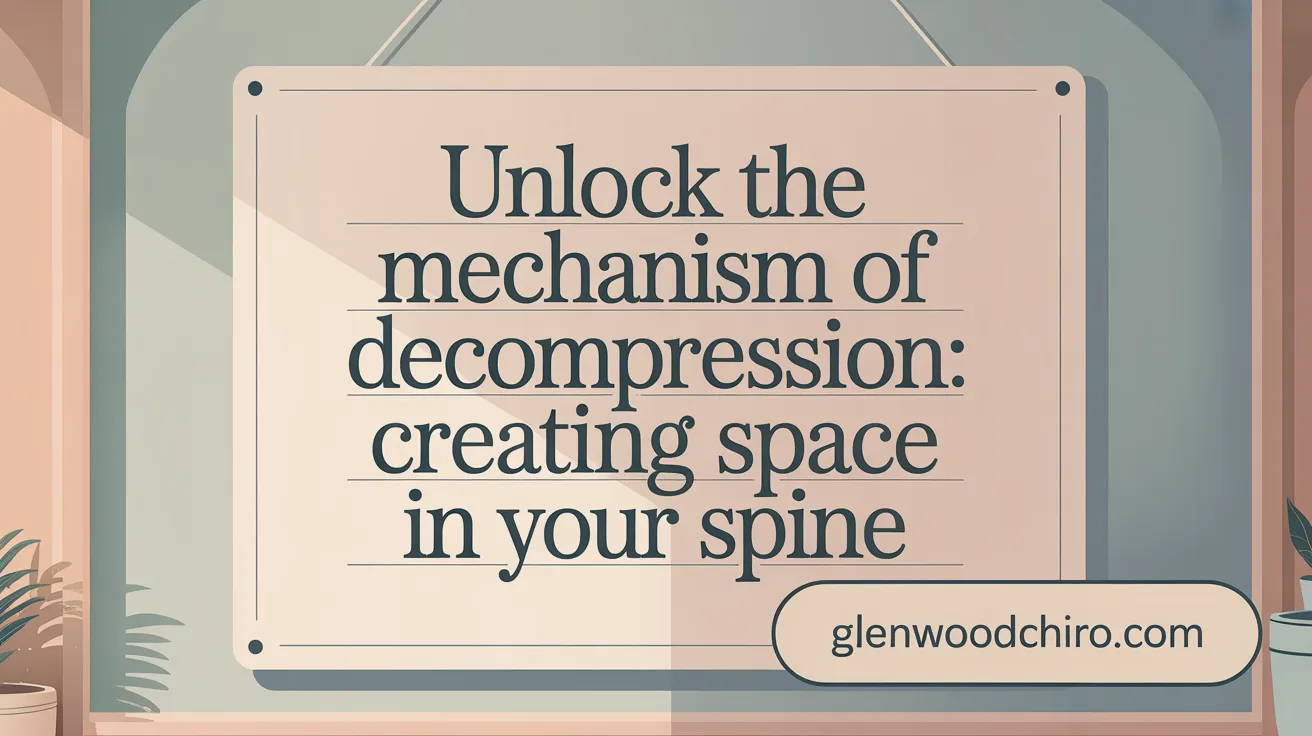Introduction to Spinal Decompression Therapy and Its Growing Popularity
What is spinal decompression therapy?
Spinal decompression therapy is a gentle, non-surgical treatment designed to relieve pressure on the spine. It involves a specialized motorized table that gently stretches and relaxes the spine in controlled cycles. This process creates negative pressure within spinal discs, encouraging bulging or herniated discs to retract, thereby alleviating nerve compression and promoting natural healing.
Non-invasive nature and patient suitability
This therapy is non-invasive, requiring no medications, injections, or downtime, making it a comfortable option for many patients. It is personalized to each individual's condition and generally involves multiple sessions over several weeks. However, it is not suitable for everyone; patients with advanced osteoporosis, spinal fractures, tumors, or spinal implants are typically excluded from treatment.
Common conditions treated by spinal decompression
Spinal decompression effectively addresses a range of spinal issues including herniated or bulging discs, sciatica, degenerative disc disease, spinal stenosis, and pinched nerves. Many patients experience significant relief from chronic back and neck pain, improved mobility, and decreased nerve-related symptoms through this therapy.
How Spinal Decompression Therapy Works to Alleviate Nerve Pain

Mechanism of spinal decompression therapy
Spinal decompression therapy is a non-surgical method that aims to relieve nerve pain by gently stretching and relaxing the spine. This therapy targets conditions where spinal nerves are compressed due to bulging or herniated discs, degenerative disc disease, sciatica, or spinal stenosis.
Use of motorized traction tables and controlled spinal stretching
During treatment, patients lie on a specialized motorized spinal decompression table. A harness is secured around the hips to stabilize the pelvis, while the table gently stretches and relaxes the spine in carefully controlled cycles. This precise mechanical traction avoids sudden movements and makes the process comfortable and painless.
Creating negative pressure to help disc retraction and healing
The therapy works by creating negative pressure in spinal discs, which encourages the retraction of disc material that may be pressing on nerves. This negative pressure also enhances the flow of oxygen, water, and nutrients into the discs, promoting natural healing of damaged tissue. By reducing pressure on nerves, symptoms like pain, numbness, and tingling can be significantly alleviated.
Typical treatment duration and patient experience
Each spinal decompression session typically lasts between 30 to 45 minutes. Most patients undergo multiple spinal decompression sessions over several weeks to gain optimal relief. Treatment is generally painless and described as relaxing. Many report a decrease in pain and improved mobility within weeks, reinforcing the therapy’s role as a gentler alternative to surgery for nerve compression issues.
Conditions Benefiting from Spinal Decompression and Its Effectiveness

Which Conditions Can Benefit from Spinal Decompression Therapy?
Spinal decompression therapy targets several specific spinal conditions that cause nerve compression and associated pain. These include herniated discs, where disc material protrudes and presses on nerves; bulging discs, which similarly exert pressure but with less severe protrusion; sciatica, characterized by shooting pain from nerve irritation along the leg; spinal stenosis, a narrowing of the spinal canal causing nerve constriction; and degenerative disc disease, where discs lose hydration and function over time causing pain and reduced mobility.
How Does Spinal Decompression Relieve Nerve Compression and Enhance Function?
The therapy works by gently stretching the spine using a motorized traction table that creates negative pressure in spinal discs, which encourages herniated or bulging discs to retract away from nerve roots, reducing nerve compression. Additionally, decompression facilitates increased flow of oxygen, water, and nutrients into the discs and adjacent tissues, promoting healing and nerve function restoration. This improved circulation helps to alleviate symptoms like numbness, tingling, and weakness.
What Are the Primary Benefits of Spinal Decompression?
Spinal decompression offers multiple significant benefits:
- Pain Reduction: By relieving pressure on nerves, patients often experience decreased back pain and radiating limb pain.
- Improved Mobility: Gently stretching and realigning the spine reduces stiffness and increases range of motion.
- Avoidance of Surgery: It serves as a non-invasive, drug-free alternative that can help many patients avoid surgical interventions like discectomy or laminectomy.
Overall, spinal decompression is a carefully tailored, evidence-informed treatment that addresses the root causes of spinal nerve pain and contributes to long-term spinal health and pain relief.
Non-Surgical Versus Surgical Decompression: When Is Each Appropriate?

Non-surgical decompression as a first-line treatment option
Non-surgical spinal decompression therapy is typically the initial approach for managing back and neck pain caused by conditions such as herniated or bulging discs, spinal stenosis, and degenerative disc disease. This gentle, non-invasive treatment involves the use of a motorized traction table to stretch and relax the spine, creating negative pressure in spinal discs that encourages disc material to retract and reduces pressure on spinal nerves. Benefits include minimal downtime, no need for medications or injections, and the promotion of natural disc healing through improved circulation of oxygen, water, and nutrients. It is often combined with complementary therapies like chiropractic care, physical therapy, and targeted exercises to enhance recovery.
Surgical options and types such as microdiscectomy, laminectomy, and their indications
When conservative, non-surgical methods fail to relieve pain or when nerve compression is severe, surgical decompression may be recommended. Common surgical procedures include microdiscectomy and laminectomy. Microdiscectomy involves the precise removal of herniated disc material pressing on nerves using minimally invasive techniques, reducing tissue damage and promoting faster recovery. A laminectomy entails removing part of the vertebral bone (lamina) to relieve pressure caused by spinal stenosis or tumors. These surgical options are designed to directly decompress nerve roots and restore spinal function when indicated by patient symptoms and diagnostic imaging.
Criteria and patient evaluation for decompression suitability
Patient candidacy for spinal decompression, whether surgical or non-surgical, is determined through comprehensive evaluations that include medical history, physical examination, and diagnostic tests such as MRI, CT scans, electromyography, and nerve conduction studies. Non-surgical decompression is contraindicated in cases involving advanced osteoporosis, spinal fractures, tumors, or severe spinal instability. Surgical intervention is considered when patients exhibit persistent pain, neurological deficits such as numbness or weakness, or loss of bladder and bowel control.
Advantages and limitations of each approach
Non-surgical decompression offers a low-risk, drug-free option with the benefits of being painless, relaxing, and effective for many patients, especially when started early. It may help patients avoid surgery altogether. However, its effectiveness depends on the severity of the condition and patient adherence to therapy. Surgical decompression provides definitive relief by physically removing the source of nerve compression, often resulting in significant and rapid symptom improvement. Nevertheless, surgery carries inherent risks, requires recovery time, and may not be suitable for all patients. Ultimately, treatment should be individualized, with a multidisciplinary team assessing the best approach to optimize patient outcomes.
Supporting Therapies and Complementary Care in Spinal Decompression Programs
How are chiropractic adjustments, physical therapy, acupuncture, and laser therapy integrated into spinal decompression programs?
Spinal decompression therapy is frequently combined with other complementary treatments to enhance patient outcomes. Chiropractic adjustments help correct spinal alignment and reduce mechanical stress, supporting the decompression's goal of relieving nerve pressure. Physical therapy focuses on rehabilitation and restoring movement through targeted exercises and neuromuscular re-education, critical for long-term recovery.
Adjunctive therapies like acupuncture for back pain and cold laser therapy in spinal care provide additional benefits by helping reduce inflammation and muscle tension, facilitating pain relief and tissue healing. These modalities complement spinal decompression by addressing soft tissue components that contribute to chronic pain.
Why is patient education and home exercise important in spinal decompression care?
Patient education empowers individuals to participate actively in their recovery. Understanding the nature of their spinal condition and the purpose of decompression helps improve adherence to treatment plans. Home exercises, such as knee-to-chest stretches for spine health, pelvic tilts, and cat-cow stretches, promote spinal flexibility and strength. These exercises improve circulation and nutrient flow to spinal discs, supporting the natural healing process initiated by decompression therapy.
Home strategies also help maintain spinal alignment, reduce stiffness, and prevent future injuries by keeping muscles and ligaments balanced and resilient. Educated patients with customized home routines experience better symptom management and improved functional outcomes.
What is the role of multidisciplinary approaches in enhancing treatment outcomes?
An integrated, multidisciplinary approach leverages the strengths of various healthcare disciplines to address the complex nature of spinal conditions comprehensively. Combining spinal decompression with chiropractic care, physical therapy, acupuncture, and patient education creates a holistic program that targets both structural and soft tissue components of pain.
This method improves mobility, reduces nerve irritation, decreases inflammation, and promotes tissue repair simultaneously. It also enhances patient satisfaction by tailoring treatment plans to individual needs and progress, often resulting in faster recovery and reduced reliance on invasive surgical options.
Facilities like Glenwood Chiropractic Center and Northeast Spine and Sports Medicine exemplify this approach, offering coordinated care that includes advanced technology alongside manual therapies and home support. Such comprehensive management is especially beneficial for individuals with chronic back pain, sciatica, or degenerative disc disease seeking effective, non-surgical solutions.
Who Should Avoid Spinal Decompression Therapy and Safety Considerations
Contraindications for Spinal Decompression Therapy
Certain patients should avoid spinal decompression therapy, including those with advanced osteoporosis, spinal fractures, tumors, or spinal implants. These conditions pose risks that may complicate or worsen with decompression treatment. For more on contraindications for decompression therapy, consult spine care professionals.
Safety Profile
Spinal decompression therapy is generally safe and non-invasive, involving no medications or injections. It is a gentle therapy with minimal side effects when administered by trained professionals, offering non-invasive spine relief.
Importance of Thorough Evaluation
A comprehensive patient assessment is essential prior to treatment to confirm suitability and exclude contraindications. This evaluation helps tailor therapy and ensures optimal safety and effectiveness, as described in evaluation before decompression therapy.
Patient Experience During Therapy
Patients typically find spinal decompression gentle and relaxing. A harness secures the hips while the spine is stretched cyclically on a motorized table, with sessions lasting about 30 to 45 minutes. The process is usually painless, with many experiencing comfort and gradual symptom relief, highlighting the benefits of motorized spinal decompression table treatment.
The Future of Spinal Decompression in Managing Nerve Pain
Spinal decompression is a proven, non-invasive therapy that gently relieves pressure on spinal discs and nerves.
It offers significant benefits for conditions like herniated discs, sciatica, and spinal stenosis by promoting natural healing through improved circulation and nutrient flow.
As a drug-free option requiring little downtime, it supports enhanced mobility, pain relief, and better overall spinal health.
Patients experiencing chronic nerve pain are encouraged to seek professional evaluation to determine if spinal decompression is appropriate for their condition.
Care plans are personalized, often combining decompression with complementary therapies such as physical rehabilitation and chiropractic care to address the root causes holistically.
This integrated, patient-centered approach is shaping the future of safe and effective pain management for those with nerve-related spinal conditions.
